Hanoi, the bustling capital of Vietnam, is not just famous for its timeless architecture, serene lakes, and rich history but also for its exceptional culinary scene. From the steamy bowls of noodle soups to the aromatic, grilled delicacies, this city is a paradise for food lovers. The essence of Hanoi’s cuisine lies in its simplicity, using fresh ingredients and minimal cooking methods.

Yet, these simple techniques yield extraordinarily flavorful dishes that leave a lasting impression. Picture yourself strolling down a narrow street, the aroma of grilled pork wafting through the air, the sizzle of sizzling tofu greeting your ears, and the sight of vendors artfully preparing dishes right before your eyes. Hanoi’s food landscape offers a unique gastronomic journey that not only satisfies the palate but also gives an authentic glimpse into Vietnamese culture and tradition.
Must-try traditional dishes
Hanoi’s culinary identity is deeply rooted in its traditional dishes, which have been crafted and perfected over generations. Sampling these iconic recipes is an essential part of experiencing the city’s vibrant food culture. Whether it’s the pho, a quintessential Vietnamese soup, or the bun cha, a combination of grilled pork and vermicelli, each dish offers a distinct taste of Hanoi’s history and hospitality.
Pho – The iconic Vietnamese noodle soup
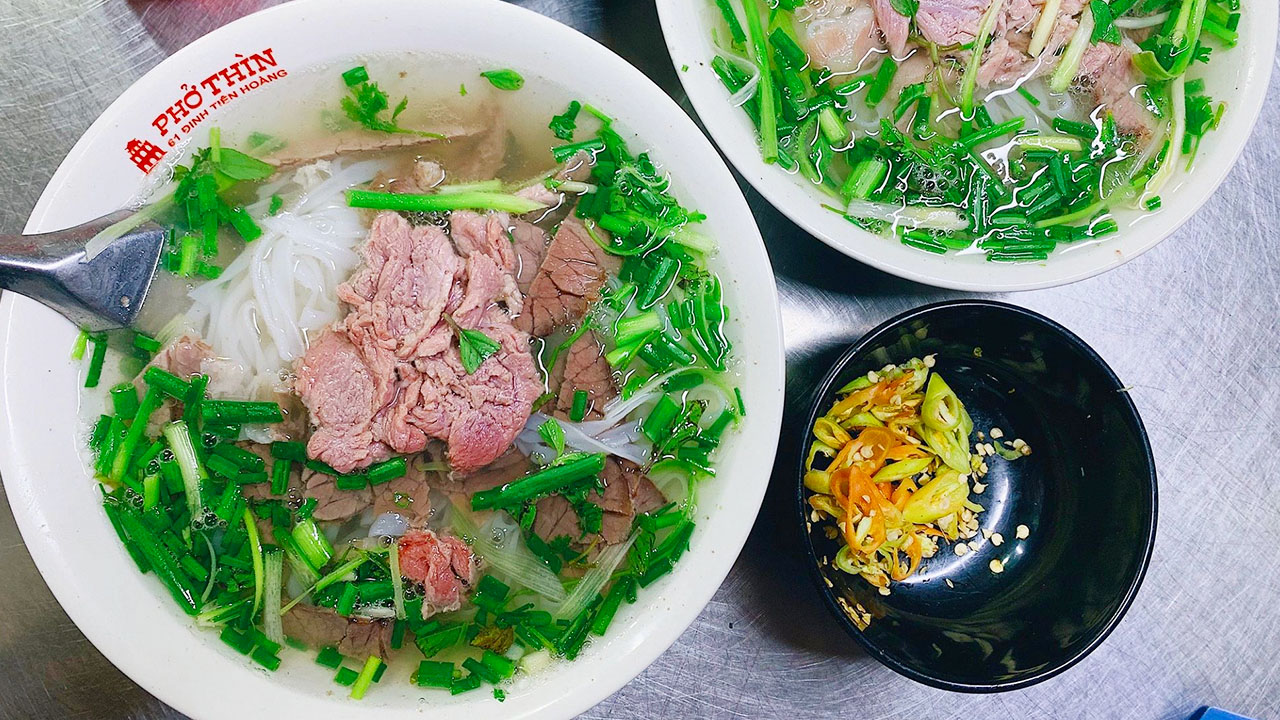
Pho is more than just a dish in Vietnam; it’s a culinary representation of Vietnamese culture. Originating from Hanoi, pho typically consists of a savory and aromatic broth, flat rice noodles, tender slices of meat (usually beef or chicken), and fresh herbs.
Key Elements of Pho
- Broth: This is the soul of pho, made by simmering beef or chicken bones for hours, sometimes overnight. It’s enriched with spices such as star anise, cloves, cardamom, and cinnamon, along with onion and ginger, creating a deeply rich and fragrant broth.
- Noodles: Known as bánh phở, these flat rice noodles are soft yet slightly chewy. They are blanched just before serving to ensure they remain fresh.
- Meat: Traditionally featuring thinly sliced raw beef or shredded chicken. When served, the hot broth cooks the meat, resulting in a tender and succulent texture.
- Herbs and Condiments: Common garnishes include cilantro, green onions, and bean sprouts. Diners often adjust the flavors to their liking with lime wedges and fresh chili.
- Regional Variations: Hanoi-style pho (pho Bac) is characterized by a clear, less sweet broth compared to its southern counterpart (pho Nam), which often includes more herbs and a sweeter taste.
Popular Places to Try Pho in Hanoi
Some of the renowned spots to enjoy this delightful dish include:
- Phở Gia Truyền Bat Dan: Located at 49 Bat Dan Street, this outlet is famous for its traditional beef broth.
- Phở Suong: Found at 24 Trung Yen Lane, this place is known for its unique chicken pho.
- Phở 10 Ly Quoc Su: Situated at 10 Ly Quoc Su Street, this restaurant is praised for its rich flavors and variety of pho options.
Indulging in a bowl of pho is like savoring a piece of Vietnamese culture. The harmonious balance of flavors, the communal dining atmosphere, and the aroma of the broth collectively create a memorable experience. A visit to Hanoi is incomplete without immersing yourself in this iconic dish, which speaks volumes about the country’s culinary heritage and nuance.
Bun cha – Grilled pork with rice vermicelli
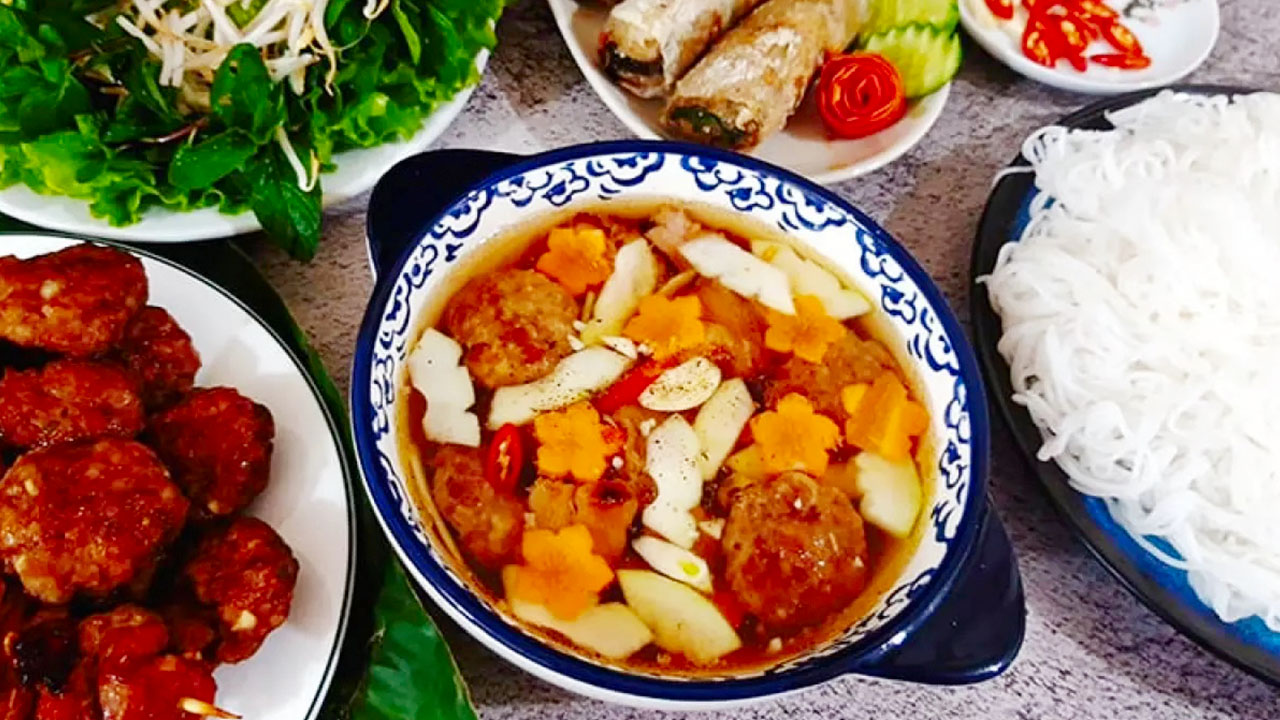
Bun cha is another iconic dish that embodies Hanoi’s culinary tradition. Traditionally enjoyed as a lunch option, bun cha comprises grilled pork (often pork patties and slices of pork belly), served on a bed of rice vermicelli noodles.
- The Pork: The heart of bun cha is the grilled pork, which is marinated and then grilled to perfection, giving it a smoky and savory flavor. The dish typically includes both nem (fried spring rolls) and grilled pork strips.
- Vermicelli: The rice vermicelli noodles act as the base, providing a soft and delicate contrast to the grilled pork.
- Herbs and Vegetables: Fresh herbs such as basil, mint, and cilantro, along with pickled vegetables like carrots and papaya, are served alongside, adding freshness and crunch.
- Dipping Sauce: The accompanying fish sauce is diluted with vinegar and sweetened, providing a tangy and slightly sweet complement to the savory pork.
Obama’s Favorite Dish
Bun cha gained international fame when former U.S. President Barack Obama enjoyed it during his visit to Hanoi, highlighting its universal appeal.
Top Spots to Enjoy Bun Cha in Hanoi
- Bun Cha Huong Lien: Located at 24 Le Van Huu Street, this place is famously known as “Bun Cha Obama” after his visit.
- Bun Cha Ta: Situated at 21 Nguyen Huu Huan, this eatery is celebrated for its authentic flavors and cozy setting.
- Bun Cha Nem Cua Be Dac Kim: Found at 1 Hang Manh Street, known for its combination of traditional bun cha and crab spring rolls.
Bun cha exemplifies the vibrant and fresh characteristics of Vietnamese cuisine. The smoky, caramelized notes of the grilled pork, balanced with the fresh herbs and tangy dipping sauce, make it a must-try dish when visiting Hanoi. It’s a meal that not only delights the senses but also tells a story of Hanoi’s rich culinary legacy.
Cha ca – Grilled fish with dill and turmeric

Cha ca, specifically cha ca La Vong, is a quintessential Hanoi dish that showcases the city’s unique culinary flair. This dish features grilled fish, typically catfish marinated in turmeric and shrimp paste, accompanied by fresh dill and spring onions.
- Marinated Fish: The catfish is marinated with turmeric, shrimp paste, and other spices, allowing it to absorb a rich and aromatic flavor profile.
- Grilling: The fish is grilled until it reaches a perfect caramelization, creating a slightly crispy exterior while retaining a tender interior.
- Serving Style: It is often served sizzling in a pan, table-side, adding an interactive element to the dining experience.
- Accompaniments: The dish is served with vermicelli noodles, roasted peanuts, fresh herbs, and a traditional dipping sauce.
Communal Dining Experience
One of the unique aspects of cha ca is the communal nature of its preparation. Diners often partake in the cooking process, placing additional ingredients into the sizzling pan as they eat, enhancing the communal dining experience.
Renowned Locations to Savor Cha Ca
- Cha Ca La Vong: Located at 14 Cha Ca Street, this restaurant is synonymous with the dish and offers an unparalleled traditional experience.
- Cha Ca Thang Long: Found at 31 Duong Thanh, known for its rich flavors and high-quality ingredients.
- Cha Ca La Vong 2: Another branch of the famed restaurant, providing a similar traditional ambiance and flavor.
Cha ca represents the complexity and depth of Vietnamese cuisine. The interplay of the aromatic turmeric, the slightly crispy fish, and the fresh herbs creates a symphony of flavors that are both satisfying and intriguing. It’s a distinct dish that captures the essence of Hanoi’s gastronomy and is a testament to the city’s innovative culinary spirit.
Banh mi – Vietnamese sandwich
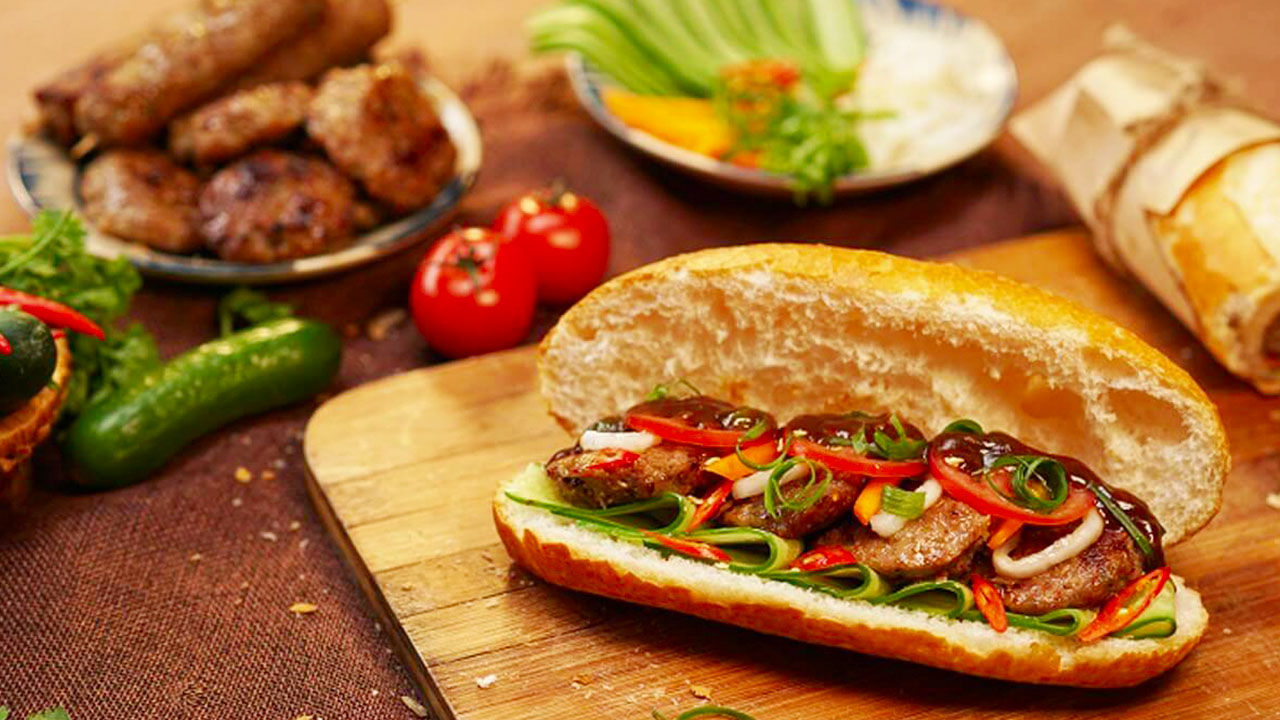
Banh mi is perhaps the most famous Vietnamese dish worldwide, combining French influences with Vietnamese ingenuity. This sandwich features a crispy baguette filled with a fusion of ingredients from both culinary heritages.
- Bread: The foundation of banh mi is the crispy, airy baguette a product of French influence during the colonial period.
- Fillings: Traditional fillings include grilled pork, chicken, beef, or pate, along with fresh vegetables like cucumber, pickled carrots, and cilantro.
- Condiments: Mayonnaise, soy sauce, or chili sauce add bursts of flavor, enhancing the overall taste.
Banh mi Varieties and Popularity
There are countless variations of banh mi, with some of the most popular fillings being:
- Pate: Typically liver pate, adding a rich, creamy texture.
- Grilled Meats: Pork or chicken are common options.
- Fried Egg: A popular addition for extra richness.
- Tofu: Vegetarian-friendly option.
- Pickled Vegetables and Fresh Herbs: Adding a zesty crunch.
Top Spots to Enjoy Banh Mi in Hanoi
- Bami Bread: Known for its Hoi An-inspired bread and diverse fillings.
- Banh Mi Minh Nhat: Famous for its success on Vietnamese MasterChef.
- Banh Mi Dan To: Offers unique stir-fried fillings.
- Banh Mi 25: Located in the Old Quarter, renowned for its variety.
- Nguyen Sinh Bakery: One of the oldest establishments, famed for its exquisite pate.
Banh mi is an essential street food staple, offering an extraordinary culinary experience at an affordable price, typically ranging from 20,000 to 50,000 VND. This sandwich is not just a quick meal; it’s a journey through Vietnam’s history and culture, encapsulated in a perfect blend of flavors and textures.
What to eat in Hanoi? Popular street foods
Hanoi’s streets are bustling with vendors offering an array of mouth-watering street foods that are not only convenient but also representative of the city’s culinary richness. These street foods are an integral part of the Hanoi experience, providing both locals and tourists with quick, tasty, and affordable snacks.
Goi cuon – Fresh spring rolls
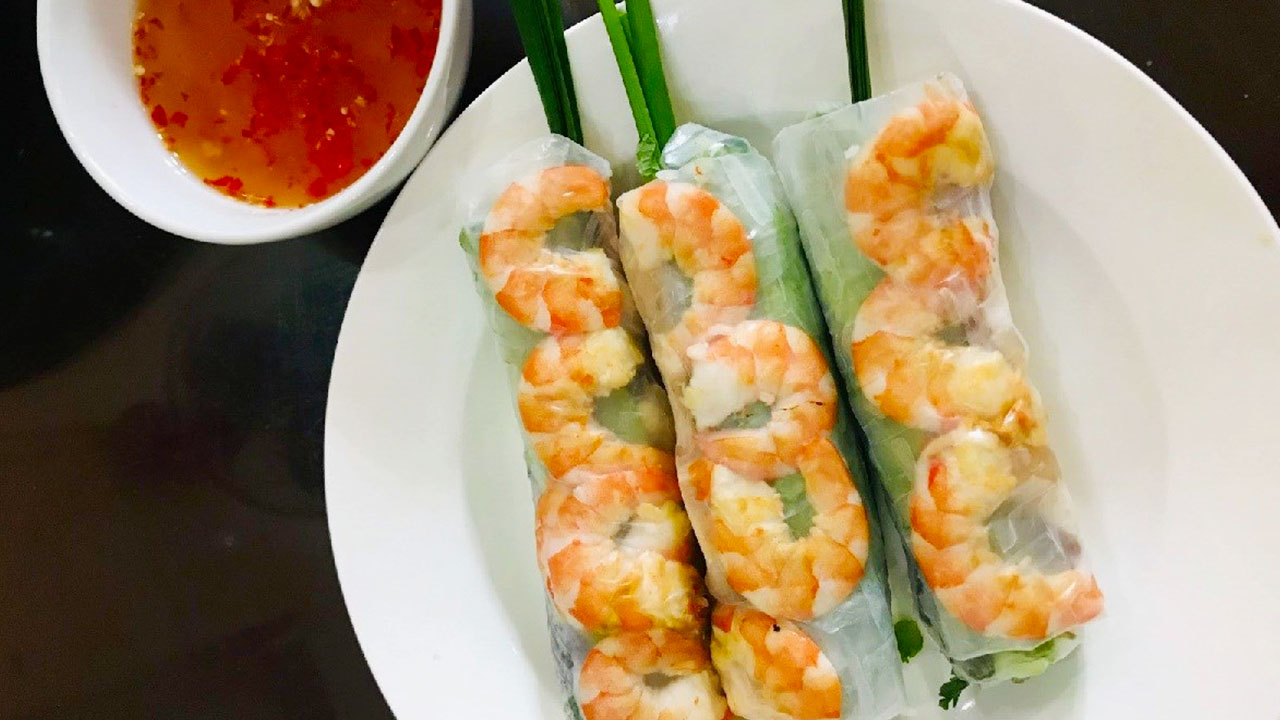
Goi cuon, also known as Vietnamese fresh spring rolls or “summer rolls”, are a light and healthy street food found throughout Hanoi. These rolls are filled with a variety of fresh ingredients, including shrimp or pork, vermicelli noodles, and an assortment of herbs and vegetables, all wrapped in rice paper.
- Ingredients: The fundamental components include shrimp or pork, vermicelli noodles, lettuce, mint, cilantro, and various other fresh vegetables.
- Rice Paper: The translucent rice paper wraps these ingredients, keeping them fresh and intact.
- Dipping Sauces: Commonly served with hoisin sauce, peanut sauce, or a vinegar-based sauce, adding depth and savoriness to the rolls.
Popular Places to Try Goi Cuon
- Cuon N Roll: Located at 3B Dang Thai Mai, this establishment offers a variety of fresh spring rolls.
- Nem Vuông Nha Trang: Situated at 4 Ly Dao Thanh, known for its tasty and fresh spring rolls.
Goi cuon is celebrated for its lightness and healthiness, making it an ideal snack or appetizer. The combination of fresh herbs, soft vermicelli, and savory shrimp or pork, all wrapped in delicate rice paper, creates a perfect balance of flavors and textures, reflecting the essence of Vietnamese cuisine.
Ngo chien bo – Vietnamese fried corn

Ngo chien bo, or Vietnamese fried corn, is another beloved street food in Hanoi, cherished for its simplicity and delicious flavor. This snack features fresh corn kernels sautéed in butter, often topped with crispy fried shallots or green onions.
- Corn Kernels: Fresh corn is used, which provides natural sweetness and juiciness.
- Butter and Seasonings: The corn is sautéed in butter, giving it a rich and savory flavor. Seasonings such as salt and sometimes a bit of sugar are added.
- Crispy Toppings: Fried shallots or green onions add a crunch and additional burst of flavor.
Where to Find Ngo Chien Bo
- Ngo Chien Bo Thinh Vuong: Located at To Ngoc Van Street, this spot is famous for its wonderfully prepared fried corn.
Ngo chien bo is a delightful snack, perfect for enjoying while wandering the streets of Hanoi. The combination of buttery, crisp corn and savory toppings makes it a crowd-pleaser, showcasing the simplicity yet ingenuity of Vietnamese street food.
Nem chua ran – Fried fermented pork rolls
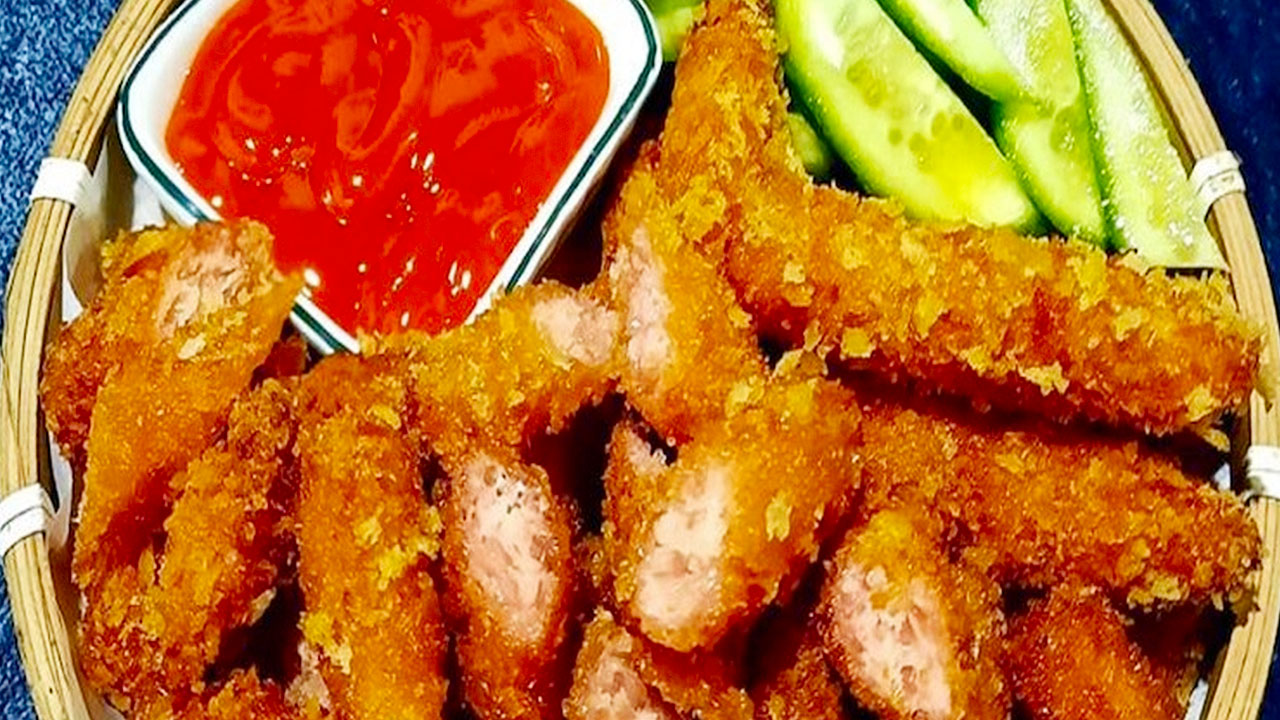
Nem chua ran is a uniquely Vietnamese street food, known for its distinct flavor and texture. These rolls are made from fermented minced pork, combined with spices and garlic, then coated in a light batter and deep-fried until golden and crispy.
- Fermented Pork: The pork is fermented, giving it a slightly tangy flavor profile.
- Coating and Frying: The rolls are lightly battered and fried, resulting in a crunchy exterior and a savory interior.
- Accompaniments: Often served with fresh herbs and a dipping sauce for added freshness and flavor.
Recommended Spots for Nem Chua Ran
- Nem Nuong Hang Tre: Located at 10 Hang Tre Street, this place is renowned for its delicious and crispy fried pork rolls.
- Nem Chua Ran Nha Trang: Found at 21 Hang Than, known for its authentic taste and quality ingredients.
Nem chua ran embodies the balance of flavors and textures that is characteristic of Vietnamese cuisine. The tangy, savory pork encased in a crispy shell creates a satisfying snack that’s a favorite among locals and visitors alike.
Bia hoi – Vietnamese fresh beer
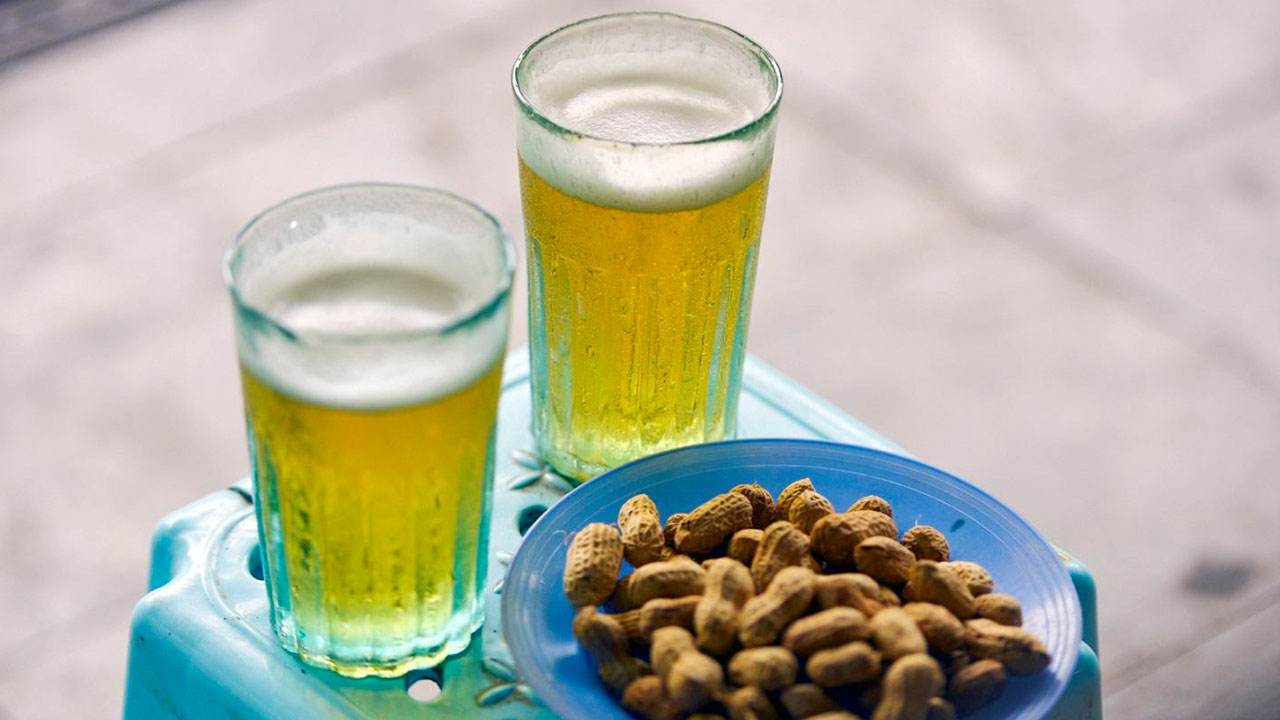
Bia hoi is a quintessential part of the Hanoi street food scene. This light, refreshing draft beer is brewed daily and enjoyed in small, local bars or roadside vendors.
- Brewed Daily: Bia hoi is brewed fresh every day, offering a crisp and light taste.
- Low Alcohol Content: The beer is typically low in alcohol, making it ideal for casual, day-long drinking.
- Social Experience: Enjoyed in makeshift street-side bars with small plastic stools, it fosters a communal and social environment.
Popular Bia Hoi Spots in Hanoi
- Ta Hien Street: Known as “Beer Street,” this is the heart of Hanoi’s bia hoi culture, bustling with locals and tourists alike.
- Bia Hoi Ha Noi Corner: Situated at 53 Hang Buom Street, a popular spot for enjoying this traditional drink.
Bia hoi costs just a few thousand dong per glass, making it an incredibly affordable and popular choice. The experience of sipping on this refreshing brew while seated on small plastic stools, amidst the animated atmosphere of Hanoi’s streets, is a quintessential part of the city’s culinary culture.
Unique regional specialties
Hanoi’s culinary landscape is also rich with unique regional specialties that provide a deep dive into local flavors and practices. From sophisticated noodle soups to communal hotpots, these dishes capture the essence of Hanoi’s culinary creativity and regional pride.
Bun thang – Noodle soup with egg and chicken

Bun thang is a delicate and intricate noodle soup that represents the sophisticated culinary traditions of Hanoi.
Ingredients
- Rice Vermicelli (Bún): Thin rice noodles serve as the base of this dish.
- Chicken: Often shredded and added as a primary protein.
- Egg: Thinly sliced omelet strips add richness and texture.
- Pork: Occasionally included to deepen the broth’s flavor.
- Herbs and Vegetables: Fresh herbs like cilantro and scallions, along with fried shallots, are common garnishes.
- Broth Ingredients: The broth, flavored with fish sauce, dried shrimp, and sometimes pineapple, achieves a subtle yet complex taste.
Preparation
The preparation of bun thang is meticulous. It begins with simmering chicken and pork to create a rich broth. Ingredients are layered artistically in a bowl, with rice vermicelli first, followed by chicken, egg strips, and garnishes. Hot broth is poured over just before serving.
Cultural Significance
Bun thang is more than just a dish it represents culinary sophistication and the traditions of Hanoi. Its flavors reflect both Northern Vietnamese cooking styles and French culinary techniques from the colonial period. Often enjoyed as a breakfast dish or a light lunch, bun thang showcases Hanoi’s preference for fresh, delicate flavors.
Where to Find Bun Thang
- Bun Thang Ba Duc: Located at 48 Cau Go Street, this spot is known for its authentic and meticulously prepared bun thang.
- Bun Thang Hang Hanh: Situated at 29 Hang Hanh, celebrated for its rich broth and delectable garnishes.
Bun thang stands as a testament to Hanoi’s rich culinary heritage, merging simplicity with complexity and reflecting the city’s vibrant culture and history.
Bún riêu – Crab noodle soup with tomato broth
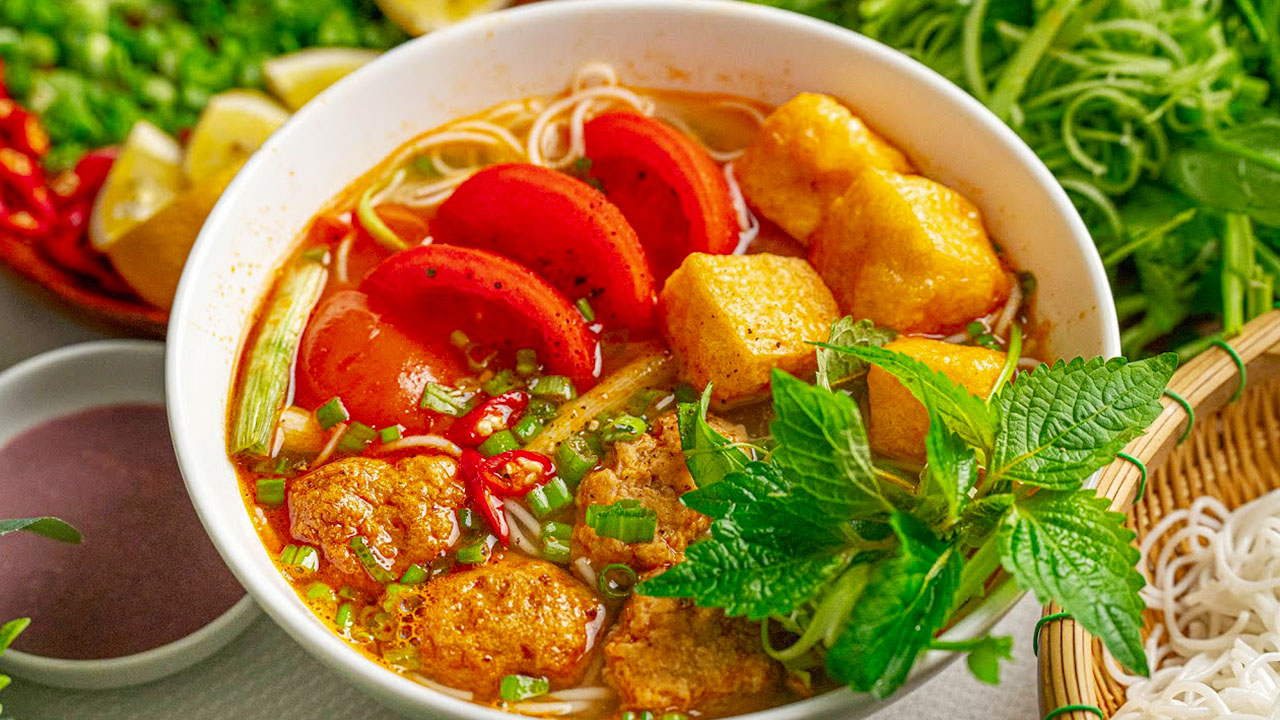
Bún riêu is a popular dish in Hanoi, known for its vibrant tomato-based broth and the unique flavor of crab.
- Tomato Broth: The bright and tangy broth forms the backbone of this dish, often cooked with tomatoes and crab paste.
- Vermicelli Noodles: The soup features rice vermicelli noodles that absorb the rich flavors of the broth.
- Crab Meat: Pounded crab meat adds a distinct and delectable taste.
- Fried Tofu: Deep-fried tofu pieces add texture and absorb the flavor-rich broth.
- Blood Curd: Occasionally included, providing a rich, savory note.
- Herbs and Vegetables: Fresh herbs and chili are served on the side for added freshness and customization.
Popular Bún Riêu Spots
- Bun Rieu Cua Hang Bac: Located at 11 Hang Bac, known for its hearty and flavorful bun rieu.
- Bun Rieu Ganh Hang Chieu: Situated at 40 Hang Chieu, praised for its delicious crab broth and toppings.
Bún riêu offers a taste of Hanoi’s creativity with its combination of savory crab and sweet tomato flavors, making it a must-try when exploring the city’s culinary scene.
Lau – Vietnamese hotpot
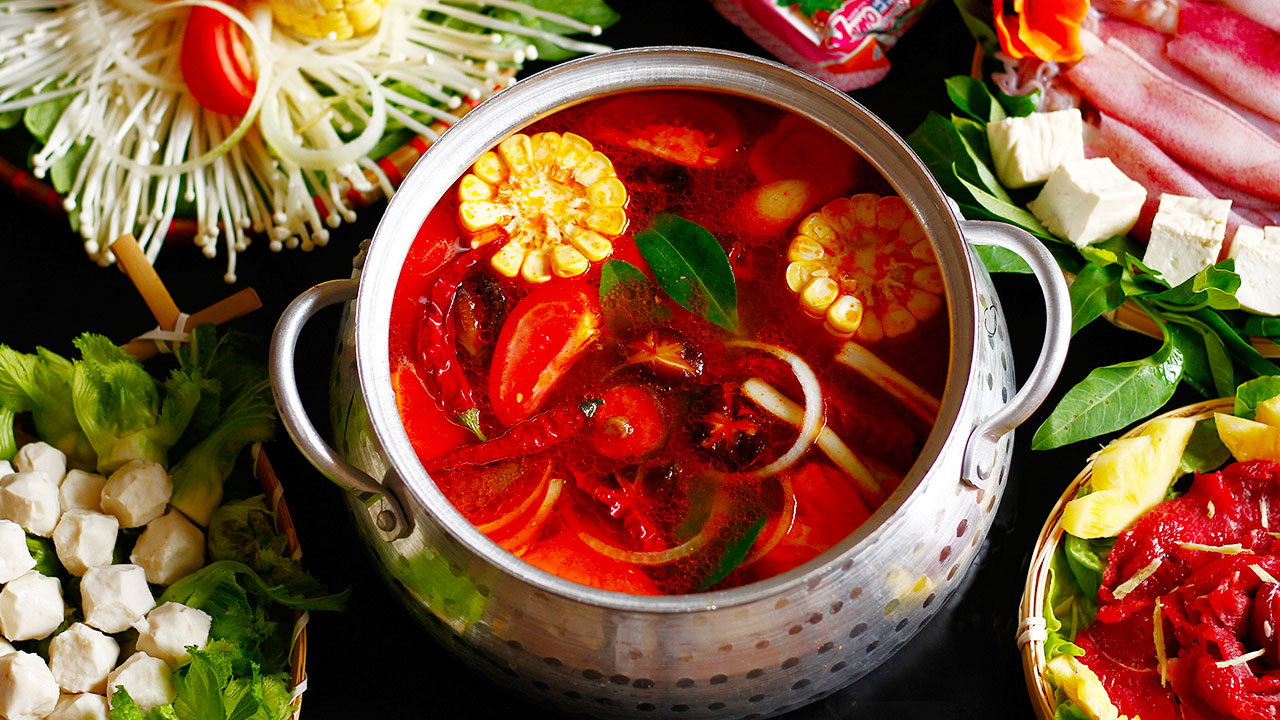
Lau, or Vietnamese hotpot, is a communal dining experience where a bubbling pot of broth is placed at the center of the table. Diners add various ingredients, creating a rich and flavorful meal.
- Broth: The broth serves as the base, often seasoned with herbs and spices.
- Ingredients: Common additions include thinly sliced meats, fresh vegetables, mushrooms, and rice noodles.
- Dipping Sauces: Various sauces are provided for flavor customization.
Where to Enjoy Lau
- Lau Bo Nhung Dam: Located at 26C Thanh Cong Street, known for its beef hotpot.
- Lau Thai BBK: Found at 57 Quán Sứ, famous for its flavorful Thai-inspired hotpot.
Lau emphasizes the communal and familial aspects of Vietnamese dining, making it a delightful and interactive meal that’s perfect for sharing among friends and family.
Banh cuon – Steamed rice rolls
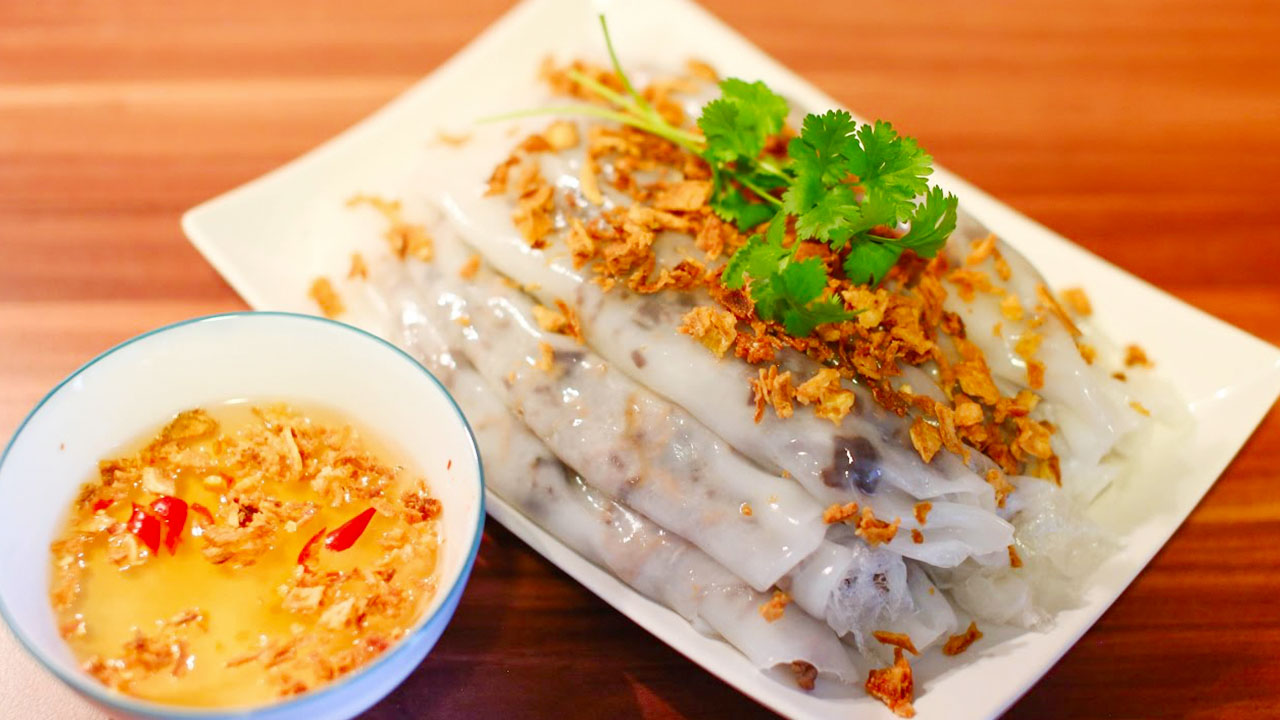
Banh cuon is a popular dish in Hanoi, featuring thin sheets of rice flour filled with savory ingredients.
- Rice Rolls: Thin, delicate sheets of rice flour are steamed to create a soft, slightly chewy texture.
- Filling: Typically ground pork, minced wood ear mushrooms, and shallots,3. Accompaniments: Often served with a side of nuoc cham, a traditional Vietnamese dipping sauce made from fish sauce, lime juice, sugar, garlic, and chili. Sometimes, sliced Vietnamese sausage (cha lua) and fresh herbs are also included to provide additional layers of flavor and texture.
Preparation and Serving
Preparing banh cuon involves a meticulous process where the rice flour batter is spread thinly over a steaming cloth. This delicate method results in translucent rice rolls that are then filled with the savory mixture and rolled up. The rolls are cut into bite-sized pieces and served typically with fried shallots and various herbs.
Popular Places to Enjoy Banh Cuon
- Banh Cuon Gia Truyen Thanh Vân: Located at 14 Trang Tien Street, this spot is renowned for its flavorful fillings and freshly steamed rolls.
- Banh Cuon Ba Hoanh: Situated at 66 To Hien Thanh Street, acclaimed for its quality and authenticity in serving traditional banh cuon.
- Banh Cuon 24: Known for its dedication to preserving the authenticity of this dish, offering a delightful experience.
Banh cuon offers a light yet satisfying meal, reflecting Hanoi’s penchant for dishes that are both delicate and flavorful. The harmonious blend of savory fillings, soft rice rolls, and aromatic herbs creates a dining experience that is not only enjoyable but also a testament to the city’s culinary heritage.
Favorite desserts and snacks
Hanoi is not just about savory dishes; it also boasts a variety of delectable desserts and snacks that provide a sweet end to any meal. These treats offer a glimpse into the city’s sweeter side and illustrate the diverse palate of Vietnamese cuisine.
Che – Vietnamese sweet soups

Che is a traditional Vietnamese dessert that comes in various forms and can be served hot or cold. It is usually made with a combination of beans, fruits, tapioca pearls, jellies, and coconut milk, creating a sweet and comforting dish.
- Popular Variations:
- Che Ba Mau: Known as Three Color Dessert, consisting of mung beans, red beans, green jelly, served over crushed ice with coconut milk.
- Che Dau Xanh: A mung bean dessert, creamy and often served warm.
- Che Chuoi: A banana-based dessert with sago pearls and coconut milk.
- Ingredients: Common ingredients include mung beans, red beans, tapioca pearls, banana, jackfruit, and coconut milk, among others.
Popular Places to Enjoy Che
- Che 4 Mùa: Located at 4 Hang Can, a popular spot known for its wide variety of che.
- Che Thai Lan: Situated at 33 Ngo Tran Hung Dao Street, offering delicious and unique variations.
Che represents a versatile and delightful aspect of Vietnamese cuisine. Whether you prefer it hot or cold, the comforting nature and sweet flavors of this dish make it a beloved dessert among locals and tourists alike.
Kem – Vietnamese ice cream

Kem, or ice cream in Vietnamese, holds a special place in Hanoi’s dessert scene, blending traditional flavors with modern presentation.
- Kem Xoi: A famous variation, combining creamy ice cream with sticky rice, often infused with pandan leaves, providing a fragrant aroma.
- Unique Flavors: Including options such as coconut, durian, green tea, and avocado, which reflect local tastes and ingredients.
Top Places to Enjoy Kem
- Kem Trang Tien: Located at 35 Trang Tien Street, this historic ice cream parlor is known for its classic flavors and traditional preparation.
- Kem Ho Tay: Found at 1 Thuy Khue Street, offers a picturesque spot by the West Lake to enjoy a refreshing treat.
- Kem Xoi Hai Phong: Situated at 29 Hang Than Street, famous for its innovative blend of ice cream and sticky rice.
Kem is not just a refreshing treat but also a reflection of Vietnam’s ability to blend traditional ingredients with contemporary dessert concepts. The variety of flavors and preparations available makes it a perfect way to cool down and indulge.
Fruit salad with condensed milk
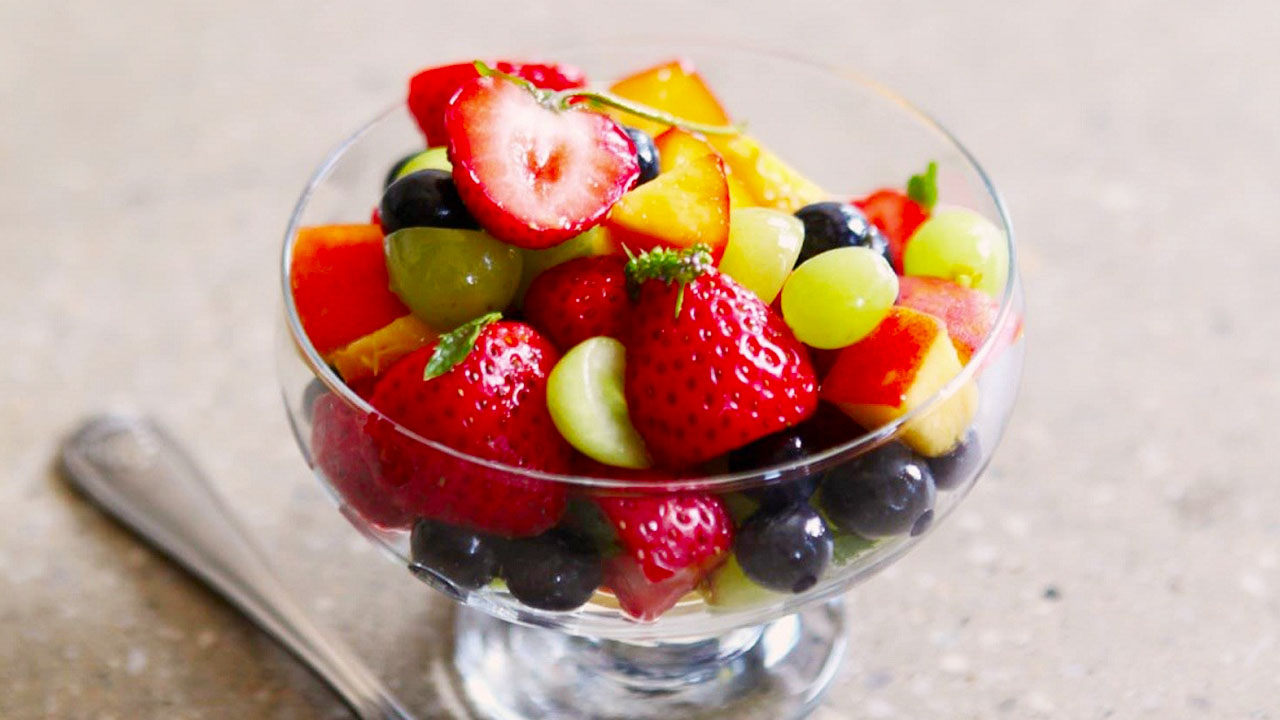
Fruit salad with condensed milk, often referred to as trái cây trộn, is a popular and refreshing dessert in Hanoi, perfect for the tropical climate.
- Common Fruits: Includes a mix of tropical fruits like mango, pineapple, papaya, dragon fruit, banana, and lychee.
- Condensed Milk: Drizzled over the mixed fruits, adding a creamy and sweet touch that enhances the natural flavors of the fruits.
- Refreshing and Light: This dessert is particularly popular during hot weather, providing a sweet and refreshing end to a meal.
Where to Find Fruit Salad with Condensed Milk
- Trái Cây Tô: Located at 22 Hang Bo Street, this place is known for its fresh and vibrant fruit salads.
- Sinh Tố Trái Cây Mix: Found at 5 Ly Thuong Kiet Street, offers a variety of fruit salads with different toppings.
Fruit salad with condensed milk is a perfect example of how simple ingredients can create a delightful and satisfying dessert. The natural sweetness of the fruits combined with the rich, creamy condensed milk makes it a must-try treat in Hanoi.
Ca phe sua – Vietnamese iced coffee
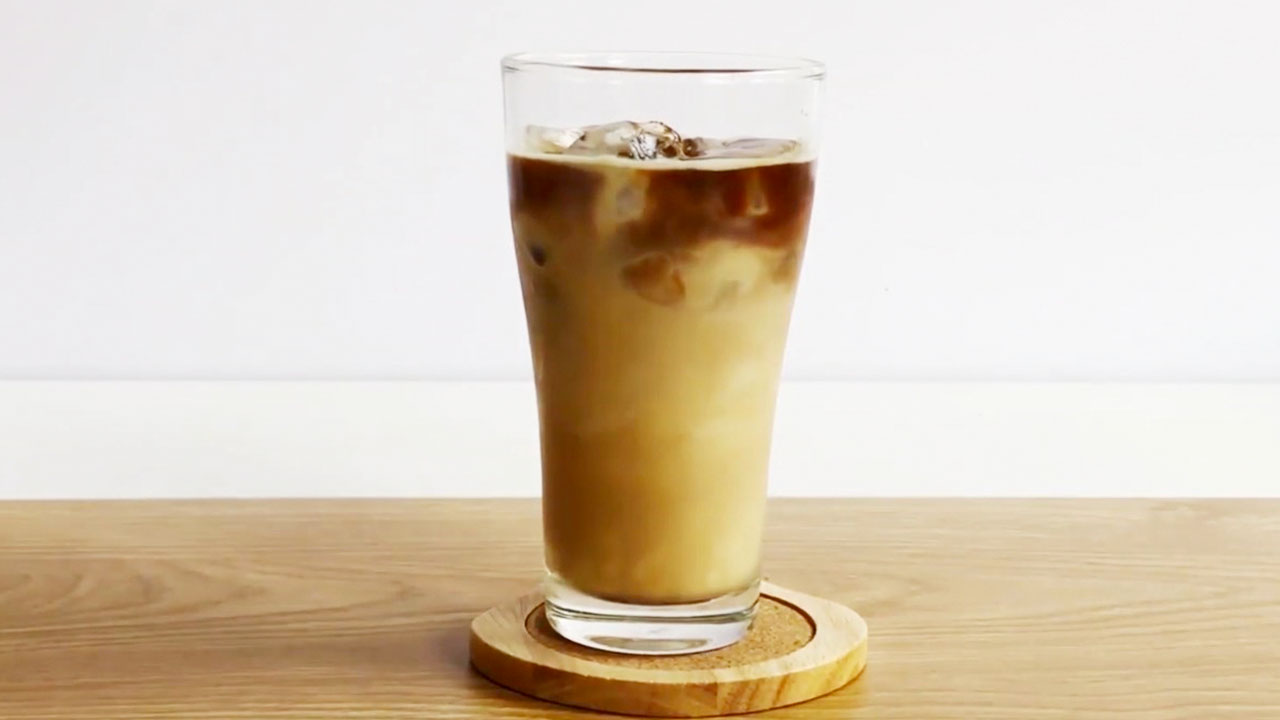
Ca phe sua, or Vietnamese iced coffee, is a staple in Vietnam’s coffee culture, especially notable in Hanoi.
- Preparation: Made using a traditional Vietnamese coffee filter (phin), which allows for a slow drip brewing process.
- Condensed Milk: Sweetened condensed milk is added to the brewed coffee, stirred thoroughly, and then filled with ice.
- Rich and Creamy: The result is a strong, rich coffee with a creamy sweetness that is incredibly refreshing.
Places to Enjoy Vietnamese Iced Coffee
- Cafe Giang: Located at 39 Nguyen Huu Huan Street, known for inventing the famous Vietnamese egg coffee.
- Cong Caphe: Found at various locations around Hanoi, offering a nostalgic ambiance and robust coffee flavors.
Ca phe sua is more than just a coffee drink; it’s an experience. The strong, robust flavor of the coffee paired with the creamy sweetness of condensed milk creates a perfect balance that is both invigorating and satisfying. It’s a drink that reflects the charm and tradition of Hanoi’s coffee culture, making it an essential part of any visit to the city.
Conclusion
Hanoi’s culinary scene is a tapestry of flavors, textures, and traditions. From the iconic pho to the refreshing ca phe sua, each dish tells a story of the city’s rich cultural heritage and its innovative culinary practices. Exploring Hanoi through its food allows visitors to experience the city’s essence in the most delightful way. Whether indulging in the hearty bun cha, savoring the delicate banh cuon, or cooling down with a cup of kem, the food in Hanoi promises to be an unforgettable adventure. Embrace the local food culture, try the myriad of street foods, and discover the beloved traditional dishes Hanoi’s culinary delights are waiting to be explored.


